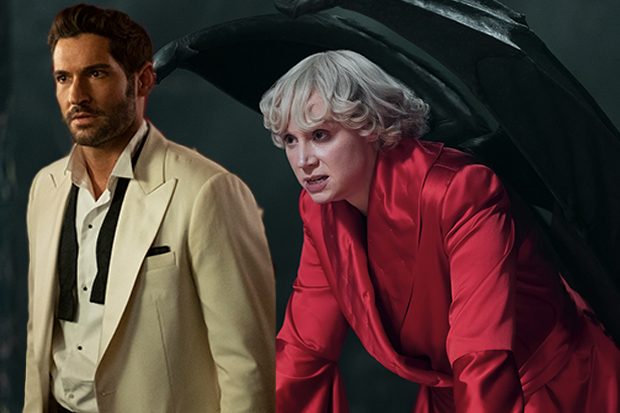 The Sandman, a critically acclaimed comic book series created by Neil Gaiman, has captivated readers since its debut in the late 1980s. Within its pages lies a rich and complex world, filled with fantastical beings and thought-provoking narratives. One of the most intriguing characters in this epic saga is Lucifer Morningstar, the fallen angel who reigns over Hell. With the announcement of a television adaptation, the popularity of The Sandman has only grown stronger, propelling it into the mainstream consciousness.
The Sandman, a critically acclaimed comic book series created by Neil Gaiman, has captivated readers since its debut in the late 1980s. Within its pages lies a rich and complex world, filled with fantastical beings and thought-provoking narratives. One of the most intriguing characters in this epic saga is Lucifer Morningstar, the fallen angel who reigns over Hell. With the announcement of a television adaptation, the popularity of The Sandman has only grown stronger, propelling it into the mainstream consciousness.
Lucifer Morningstar, also known as the Devil or Satan, is a central figure in The Sandman. Gaiman skillfully depicts him as a multi-dimensional character, exploring the depths of his persona beyond the traditional embodiment of evil. Lucifer is portrayed as a charismatic and complex individual, possessing a wry sense of humor and a keen intellect. Throughout the series, he grapples with his own identity and purpose, challenging the preconceived notions of what it means to be the Devil.
The Sandman series itself has achieved immense popularity over the years, garnering a dedicated fan base and critical acclaim. Gaiman’s imaginative storytelling and his ability to blend mythology, history, and modernity have contributed to the series’ enduring appeal. The intricate world-building, coupled with complex and relatable characters, has captivated readers from all walks of life. As the comic book industry evolved, The Sandman became a touchstone for the medium, earning multiple awards and cementing its status as a classic.
In a testament to its popularity and widespread recognition, The Sandman is set to be adapted into a highly anticipated television show. With the rise of comic book adaptations in recent years, fans have eagerly awaited the opportunity to witness Gaiman’s creation come to life on the small screen. The announcement of Lucifer Morningstar’s involvement in the show has sparked further excitement, as viewers anticipate how his nuanced character will be portrayed in this new medium.
This adaptation promises to introduce The Sandman to an even broader audience, beyond the realm of comic book enthusiasts. The medium of television allows for a more immersive experience, potentially translating the intricate storytelling and intricate visuals onto the screen. By bringing Lucifer Morningstar and the world of The Sandman to life, this television series has the potential to reignite interest in the original comic series while captivating a new generation of fans.
In conclusion, The Sandman comic book series by Neil Gaiman has left an indelible mark on the world of storytelling. Through its exploration of characters like Lucifer Morningstar, it challenges our understanding of morality and the human condition. With its upcoming television adaptation, The Sandman has the opportunity to reach an even wider audience, ensuring that its legacy endures for years to come.
Lucifer Morningstar, a character introduced in Neil Gaiman’s iconic comic series, The Sandman, captivates readers with his complex and intriguing nature. This article aims to analyze the characterization of Lucifer, shedding light on his personality traits, motivations, and overall character arc throughout the series. From his initial depiction to his transformation, Lucifer showcases a compelling evolution, ultimately becoming a central figure in the Sandman universe.
At first glance, Lucifer Morningstar epitomizes a charismatic and enigmatic figure. Gaiman portrays him as the Lord of Hell, exuding authority and power. However, beneath his unyielding exterior lies a nuanced character with remarkable depth. Lucifer possesses an unwavering sense of pride and rebellion, driven by his desire to assert his independence from his predetermined role as Hell’s ruler.
Lucifer’s personality traits are exemplified through his interactions with other characters in the series. One notable relationship is his dynamic with Morpheus, the protagonist of The Sandman. Their encounters often reveal Lucifer’s disdain for authority, as he challenges even the powerful Dream Lord. These encounters also showcase his sharp wit and intellect, making their interactions a highlight of the series.
As the story progresses, Lucifer’s motivations become clearer. Feeling burdened by his role in Hell, he decides to abdicate his throne and retire to Earth. This transition marks a significant turning point in Lucifer’s character arc. It highlights his desire for freedom and his refusal to be defined solely by his demonic origins. This decision propels him into a new journey, where he establishes his nightclub, Lux, and continues to navigate the complexities of his existence.
Key moments and storylines further shape Lucifer’s character throughout the series. One such arc involves his confrontation with his angelic siblings in the “Season of Mists” storyline. This storyline showcases Lucifer’s defiance and determination as he challenges the divine order and seeks to rectify past injustices. These moments underscore his strong moral compass, highlighting his willingness to go against the grain to uphold what he believes is right.
Another pivotal moment occurs when Lucifer embarks on a quest to retrieve his wings, which were forcibly removed. This journey reveals his vulnerability and internal conflict, as he confronts his own identity and confronts his past choices. It is through these struggles that Lucifer’s character deepens, demonstrating a newfound sense of introspection and growth.
In conclusion, Lucifer Morningstar’s portrayal in The Sandman comic series portrays a multi-dimensional character with a captivating personality and a compelling character arc. From his initial portrayal as the Lord of Hell to his journey of self-discovery and defiance, Lucifer showcases a range of emotions and motivations. His relationships, key moments, and storylines all contribute to his overall development, making him a truly memorable and beloved character within the Sandman universe.
Tom Ellis Version: Discuss the casting of Tom Ellis as Lucifer Morningstar in the television adaptation of The Sandman. Compare and contrast Ellis’s portrayal of the character with the original comic book version. Analyze how Ellis’s performance brings the character to life onscreen and any changes or adaptations made to suit the medium of television.
When it was announced that Tom Ellis would be playing Lucifer Morningstar in the television adaptation of Neil Gaiman’s iconic comic book series, The Sandman, fans were both excited and skeptical. The character of Lucifer is beloved by comic book enthusiasts, and casting the right actor to bring him to life onscreen was a daunting task. However, Ellis proved to be an inspired choice, delivering a performance that not only captured the essence of the character but also added his own unique flair.
In the original comic book version, Lucifer Morningstar is depicted as a suave and sophisticated fallen angel who abandons his throne in Hell to run a nightclub called Lux in Los Angeles. He is portrayed as charismatic, manipulative, and unapologetically self-centered. Tom Ellis’s portrayal of Lucifer stays faithful to these characteristics while infusing the character with a charming vulnerability that makes him more relatable to the audience.
One of the noticeable differences between Ellis’s Lucifer and the comic book version is the physical appearance. In the comics, Lucifer is depicted as a tall, blond, and striking figure. Ellis, on the other hand, is a brunette with a slightly shorter stature. However, this minor deviation from the original character’s appearance does not hinder Ellis’s ability to embody the essence of Lucifer. His charismatic presence and masterful delivery of lines more than compensate for any physical disparities.
Ellis’s performance brings Lucifer Morningstar to life onscreen in a way that is both captivating and irresistible. He effortlessly portrays the character’s charm, wit, and confidence, making Lucifer a delight to watch. Ellis’s ability to balance the duality of Lucifer’s character, showcasing both his seductive allure and his underlying vulnerability, showcases his versatility as an actor.
The medium of television also allows for certain changes and adaptations to be made to suit the screen. The Sandman television adaptation takes advantage of this, providing viewers with a deeper exploration of Lucifer’s character and backstory. Ellis’s portrayal allows for a more nuanced understanding of the character’s motivations and complexities, as the television format allows for a more extended and in-depth storytelling experience.
In conclusion, Tom Ellis’s portrayal of Lucifer Morningstar in the television adaptation of The Sandman is a triumph. His performance captures the essence of the character while also adding his own unique interpretation. The slight deviations from the original comic book version do not hinder Ellis’s ability to bring Lucifer to life onscreen. Instead, they allow for a more in-depth exploration of the character, showcasing Ellis’s versatility as an actor. Fans of the comic book series and newcomers alike will undoubtedly be captivated by Ellis’s portrayal of this iconic character.
Visual Representation: Explore the visual aspects of Lucifer Morningstar’s character in both the comic series and the television show. Discuss the differences and similarities in terms of costume design, physical appearance, and overall aesthetic presentation. Comment on how these visual representations contribute to the interpretation and reception of the character.
Lucifer Morningstar, the charismatic and enigmatic character known for his devilish charm, has captured the hearts of audiences worldwide through both the comic series and the television show. As fans delve into the realm of Lucifer’s visual representation, it becomes evident that there are both distinct differences and intriguing similarities between the two mediums.
When it comes to costume design, Lucifer’s portrayal in the comic series showcases him in a sleek and stylish wardrobe befitting his status as the Lord of Hell. Often seen wearing tailored suits in deep shades, Lucifer exudes an air of sophistication and power. On the other hand, the television adaptation takes a slightly different approach. With a more contemporary twist, the character’s attire becomes a fusion of modern fashion and classic elegance. The television Lucifer dons a mix of designer suits and casual attire, reflecting his adaptability to the human world. These contrasting costume designs offer audiences a glimpse into the character’s multifaceted nature, showcasing his ability to seamlessly navigate both heavenly and earthly realms.
In terms of physical appearance, Lucifer’s depiction in both the comic series and the television show mirrors his strikingly handsome and alluring persona. Sporting chiseled features and piercing eyes, his devilish allure captivates those around him. However, the comic series often portrays Lucifer with more exaggerated physical attributes, such as elongated horns and a more pronounced devilish grin. On the small screen, the television adaptation opts for a subtler approach, focusing on the character’s charm and charisma rather than emphasizing his demonic features. This slight deviation allows viewers to connect with the character on a more relatable level, ensuring that his captivating presence remains at the forefront of the narrative.
Beyond mere physical appearances, the overall aesthetic presentation of Lucifer’s character plays a crucial role in shaping the interpretation and reception of the character. In the comic series, the art style often leans towards a darker and more gothic atmosphere, reflecting the character’s origins and his connection to the underworld. This visual choice helps convey the sense of mystery and danger that surrounds Lucifer, drawing readers deeper into his captivating world. Conversely, the television adaptation opts for a brighter and more vibrant aesthetic, aligning with its modern setting and the character’s newfound life on Earth. This shift in aesthetic contributes to a more accessible and relatable portrayal of Lucifer, allowing a wider audience to engage with his story.
In conclusion, the visual representation of Lucifer Morningstar’s character in both the comic series and the television show offers a fascinating exploration of his captivating persona. Through distinct costume designs, subtle differences in physical appearance, and carefully curated aesthetic presentations, audiences are provided with unique interpretations of this beloved character. These visual representations serve as key elements in the reception and understanding of Lucifer Morningstar’s complex nature, enticing fans to immerse themselves in his captivating world, whether on the pages of a comic or through the screen of a television.



